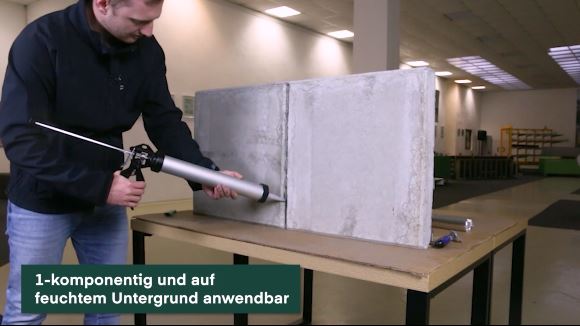Sealing concrete cracks - safely and efficiently
Protect your buildings with InnoElast®
If buildings are to be subsequently protected against water penetration, a universally applicable adhesive is required. InnoElast is the optimum solution for sealing and repairing concrete cracks. Expansion joints, construction joints and also joints in industrial floors are reliably sealed indoors and outdoors with the weather-resistant and permanently elastic as well as environmentally friendly sealant. The one-component polymer-modified sealant can also be used for sealing connections, for example, on doors, windows and penetrations and in roof areas.
- InnoElast is practically non-shrinking
- seals permanently due to its elasticity
- Fills space flexibly and completely
- very resistant and workable from -3°C
- InnoElast is applicable against pressing water
This is how InnoElast® Type 1 & Type 2 works
It is precisely the small gaps between different materials that allow moisture to get inside rooms or walls and cause damage. At the same time, the consequences, such as dangerous mold infestation, are easy and quick to prevent. With InnoElast® Type 1 and Type 2 from BT innovation, the joints can be reliably sealed. This prevents any penetration of moisture.
Whether applied to structural joints, facade joints, doors and windows, walkways, or bathrooms, InnoElast® Type 1 and Type 2 show good adhesion to almost all surfaces. Materials such as steel, aluminum, stone or wood pose no challenge to the sealant. In addition, the application can also be made on mat damp substrates indoors and outdoors. InnoElast® does not lose its special sealing properties as a result. In addition to its ability to close joints, the sealant can additionally seal and bond pipes.

This is how InnoElast® is used
Using a tubular bag gun, InnoElast® Type 1 or Type 2 is applied to a clean substrate and then cures effectively. The skin formation time is between 2 and 3 hours at a room temperature of 23°C and a humidity of 50%, and the curing time is 3mm in 24 hours. A primer is not required beforehand. However, it is recommended to insert a joint filler cord and tape the edges. Pressing and smoothing creates a strong bond with the joint edges.
Instructions - Processing as a joint sealant
Concrete does not last forever – even if the popular building material is very solid and faithfully performs its service for many decades. Especially on facades, stairs and in the plinth area, unsightly cracks occur over the years. On the exposed concrete surface, this may only be a blemish – on load-bearing elements such as piers or ceilings, this is damage that should definitely be taken seriously and remedied as quickly as possible by concrete repair. If such visible defects are not taken seriously, there is no limit to moisture penetration and corrosion continues to progress.
Cracks can have different causes and effects. Often a small crack can be repaired by yourself, while large and deep damage on the construction requires professional help. Concrete cracks usually occur when a structural component can no longer absorb the tensile forces or loads. These can be plastic shrinkage, effects in the temperature structure or the settling of the concrete in a component.
The so-called “early cracks” often occur when exposed concrete surfaces dry out quickly. This may be due to excessive heat of hydration or the cast-in-place concrete’s moisture structure being too low. This creates a tension in the material, which leads to the formation of cracks. Usually these cracks are not very deep and widely branched, but in some cases they can reach deeper layers, allowing water to penetrate beyond the capillary zone. Cracks due to temperature effects are caused by thermal expansion. Especially when the temperature difference between concrete and air is more than 15° Celsius, they occur. Settlement cracks often affect high and massive precast concrete elements , when they sink in, e.g. due to rising water or insufficient fastening of the substrate.
Provided that these concrete cracks are small, manageable and not too deep, you can reliably eliminate them yourself. InnoElast is the ideal choice here as an alternative to conventional filler to seal the concrete cracks: easy to apply, permanently sealing and can also be used on damp substrates.
The universal InnoElast sealant can also be used for cracks in the concrete floor (cellar sealing), as it fills the space flexibly and completely. This compound is very resistant and workable from -3°C. In contrast to conventional sealing methods, regrinding is not necessary here. For cracks in concrete walls, InnoElast is equally applicable against pressing water. InnoElast is your universal helper in structural sealing.